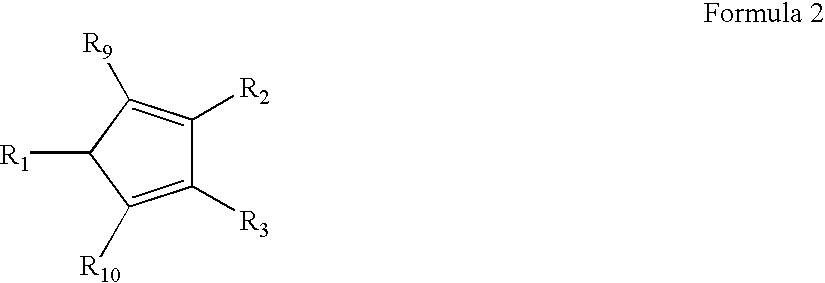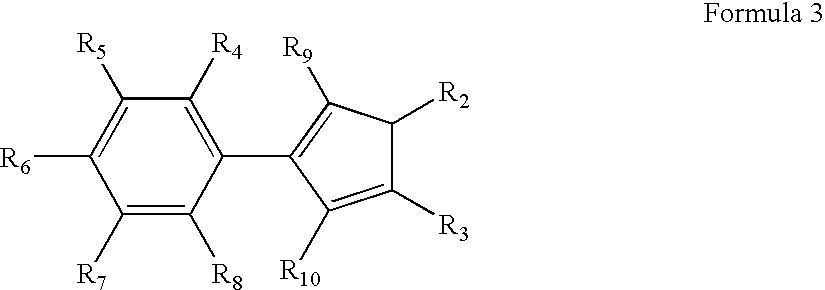High melting thermoplastic elastomeric alpha-olefin polymers (PRE/EPE effect) and catalysts therefor
a technology of thermoplastic elastomeric alpha-olefin and catalyst, which is applied in the direction of group 4/14 element organic compounds, metallocenes, organic chemistry, etc., can solve the problems of significant and disproportionately large increase in polymerization activity, and achieves productivity increase, productivities increase, and productivity increase
- Summary
- Abstract
- Description
- Claims
- Application Information
AI Technical Summary
Benefits of technology
Problems solved by technology
Method used
Image
Examples
example 1
Preparation of 2-Phenylindene, (Ligand 1)
A solution of 2-indanone (13.47 g, 102 mmol) in anhydrous benzene (100 mL) was added to phenylmagnesium bromide (3.0 M in diethyl ether, 50.9 mL, 153 mmol) at 5.degree. C. over 2.5 hours. The reaction was allowed to warm to room temperature over 30 minutes. The solution was cooled to 0.degree. C. and 150 mL of water are added. The resultant mixture was diluted with 200 mL of hexanes, neutralized with 5 M HCl, and washed with brine (2.times.100 mL). The aqueous layer was extracted with hexanes (2.times.50 mL), and the combined organic layers were dried (MgSO.sub.4), filtered, and the solvent removed in vacuo from the filtrate to yield a brown oil. This oil and p-toluenesulfonic acid (0.50 g) were dissolved in benzene (250 mL) in a round-bottom flask below a Soxhlet extractor containing 4.ANG. molecular sieves. After refluxing for 2.5 hours, the solution was filtered and cooled to 5.degree. C. overnight. The product, a white flaky solid, was co...
example 2
Preparation of Bis(2-Phenylindenyl)zirconium Dichloride, Catalyst A (Ligand 1)
A solution of n-butyllithium (1.6 M in hexanes, 3.25 mL, 5.2 mmol) was added to a solution of 2-phenylindene (1.01 g, 5.3 mmol) in tetrahydrofuran (40 mL) at -78.degree. C. over 2 minutes. The orange solution was warmed to room temperature over 30 minutes. After solvent is removed in vacuo, the yellow solid was suspended in toluene (25 mL). To this mixture was added a suspension of ZrCl.sub.4 (612 mg, 2.6 mmol) in toluene (25 mL) at room temperature. This yellow solution was stirred for 2.5 h, heated to 80 C, and filtered over a medium frit packed with Celite. The Solution was cooled to -20 C overnight, resulting in the formation of yellow-orange rod-like crystals of bis (2-phenylindenyl) zirconium dichloride (1.173 g, 82.0% yield). .sup.1 H NMR (400 MHz, 20 C, C.sub.6 D.sub.6): .LAMBDA. 7.38 (d, J=7.1 Hz, 4H), 7.17 (m, 4H), 7.10 (m, 2H), 7.04 (dd, J=6.5, 3.1 Hz, 4H), 6.90 (dd, J=6.5, 3.1 Hz, 4H), 6.41 (s,...
example 3
Preparation of Bis(2-Phenylindenyl)zirconium Dimethyl, Catalyst B (Ligand 1)
A solution of methyllithium (1.4 in diethyl ether, 0.75 mL, 1.05 mmol) was added to a solution of bis(2-phenyl-indenyl)zirconium dichloride (280 mg, 0.51 mmol) in diethyl ether (100 mL) at -100.degree. C. The bright yellow solution is warmed to room temperature over 30 minutes. After 3 hours, volatiles were removed from the colorless solution and toluene was added (25 mL). The solution was filtered over a medium frit packed with Celite, and solvent is removed in vacuo. Crystallization from toluene (1 mL) and pentane (15 mL) yields cream colored cubes (110 mg, 42.5%). .sup.1 H (400 MHz, 20 C, C.sub.6 D.sub.6): .LAMBDA. 7.28 (m, 4H), 7.16 (m, 6H), 702 (dd, J=6.4, 3.2 Hz, 4H), 6.93 (dd, J=6.5, 3.2 Hz, 4H), 6.00 (s, 4H), -0.85 (s, 6H).
PUM
| Property | Measurement | Unit |
|---|---|---|
| TM | aaaaa | aaaaa |
| Tm | aaaaa | aaaaa |
| Tm | aaaaa | aaaaa |
Abstract
Description
Claims
Application Information
 Login to View More
Login to View More - R&D
- Intellectual Property
- Life Sciences
- Materials
- Tech Scout
- Unparalleled Data Quality
- Higher Quality Content
- 60% Fewer Hallucinations
Browse by: Latest US Patents, China's latest patents, Technical Efficacy Thesaurus, Application Domain, Technology Topic, Popular Technical Reports.
© 2025 PatSnap. All rights reserved.Legal|Privacy policy|Modern Slavery Act Transparency Statement|Sitemap|About US| Contact US: help@patsnap.com



